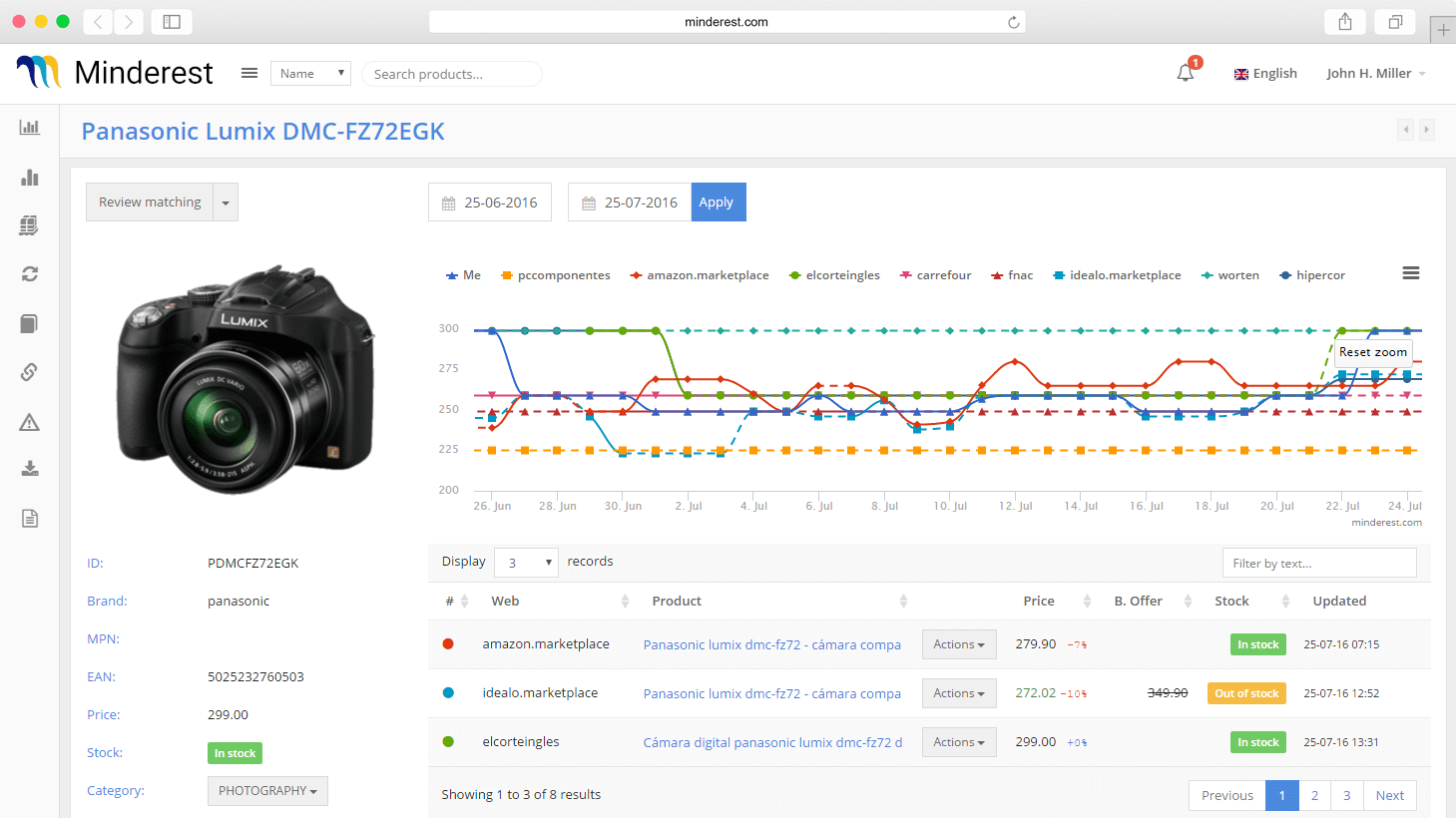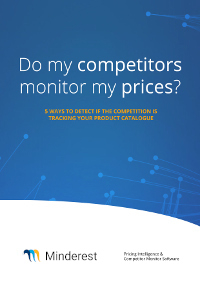Price optimization is already a factor when developing the pricing strategy of any online retailer. In the digital environment, prices change almost constantly, searching for the point where the best sales ratios are achieved with competitive prices, which continue to bring benefits to retailers. However, online price optimization techniques need competitive price comparison in order to make the best decisions. For this, dynamic pricing software is, without a doubt, your online store’s best ally.
4 benefits of price optimisation online
Currently, the online sales environment is characterised by three factors:
- A very large number of online sellers, such as marketplaces, eCommerce, resellers and even comparison engines who obtain commissions as intermediaries.
- An endless variety of products that are now accessible to billions of potential customers.
- The constant battle to capture, trap and convert visits to the online store into sales revenue.
In all of these, price always plays a fundamental role. As in traditional, or offline, selling, price remains a decisive factor for the consumer when choosing one product over another, one vendor or their competition. Of course, price was not going to play a lesser role when we move to the digital world, since options are practically infinite.
During this battle, being the cheapest option could become the best in order to get the maximum number of sales. However, we must not lose sight of the fact that the price must always meet the minimum requirements of the brand in order for it finally to be able to cover the profits of the eCommerce coffers. Price optimisation strategies are based on precisely this: providing the maximum possible benefit for your online store at all times. With this approach, price optimisation techniques will allow you to always know what the optimal selling price is for your products and that allows you to get both a good sales ratio along with the necessary profits.
Every online sales manager knows that this type of action is more than necessary in an environment in which platforms such as Amazon can change the price of their products up to six times in a day (with an average of almost four per product and day). What more concrete benefits can you gain from specialist price optimisation? Let’s look at them schematically:
- Always obtain the highest yield for each sale made.
- Increase sales in those products that, until now, did not seem to stand out in the catalogue due to their prices.
- Improve the profit margin of those products that have very little competition in the market and have good brand positioning.
- Avoid loss of profit due to prices that are out of the market or insufficient sales due to the reduction of certain products.

The relationship between dynamic pricing and price optimisation
Dynamic pricing strategies are governed by the modification of prices at times when market conditions change. These readjustments are made according to changes made by your competitors, in particular, and always aims to achieve the most competitive price possible for each product in your store. Analysing any pricing strategy, it can be perfectly affirmed that dynamic pricing is one of the techniques involved in price optimisation. For the strategy to be effective, it is necessary for product prices to adapt and change as many times as necessary in order to adjust to the market conditions.
In general, when we talk about dynamic pricing, we end up referring to price optimisation because we do not understand the implementation of one technique without the other. After all, both are necessary to make your online store maintain the sales opportunities ahead of your competition and get the maximum possible benefit from them at all times. In this sense, the circle would be closed by Competitor Price Monitoring, which provides the necessary data to conduct all these price modification actions.
What to consider during price optimisation?
Dynamic pricing actions must be carried out gingerly when it comes to making decisions. Once the competitor’s price changes have been identified, it is necessary to study the data and recognise the elements that will form the actions to be taken. Among them it will be necessary to detect the dates and times of the changes to know if they correspond to specific events, the percentage of the price change, the order in which competitors have made the change to detect the leader and verify the achievement of sales caused by this alteration in price.
With all this data, each online store can begin to parameterise the changes they want to occur in their product catalogue. With dynamic pricing tools this action can be carried out easily and automatically as it will only be necessary to indicate the rules to be followed and the order in which these are executed. Within the framework of a dynamic pricing strategy, it is also necessary to recognise the need to which the price change responds. This means indicating whether it is a special discount day, whether it is a time of high demand for a specific product or if, on the other hand, it can respond to specific competitor promotions. For example, due to an excess of stock you make an aggressive, low price, strategy to get the stock to move.
On the other hand, it is also important to consider when the dynamic pricing strategy is going to respond only to the needs of your own catalogue. It may be the case that your eCommerce is the only one with a specific product for sale. In these cases, you will have to cross-reference the stock data in your catalogue with the supply and demand records in order to adjust prices accordingly and boost sales at higher profits. If, however, what you need is to adjust the price of your products to meet a beneficial promotion per brand, it must fit your dynamic pricing strategy to keep your store’s accounts positive.
Specifically, your eCommerce can find itself in these three situations when it comes to price optimisation:
- Your store has the cheapest prices for high-demand products.
- There are competitors with better prices for the same products found in your eCommerce.
- Your prices are equal to those of your competitors but your ratio to sale is lower than the rest.
In the latter case, a price optimisation tool will be your best support, as it will help you see how far you can lower the price of your products in order to gain sales. In addition, specialised software, such as Minderest’s, will tell you at all times what type of costs your competition covers with the selling price of your products, giving you another dimension to study in your competitors’ strategy and allowing you to see for yourself in which items you can save in your business.
Choosing the best dynamic pricing tool
Dynamic pricing software implements the necessary technology to automate all the processes necessary to carry out the price optimisation of an online store. These are responsible for monitoring competitor prices and executing the actions defined by the eCommerce once they have reached certain milestones or have met the parameters defined in the strategy.
A good dynamic pricing tool is characterised by allowing its user (the eCommerce) to process as much data as possible, as well as tracking as many personalised variables as necessary. Minderest’s dynamic pricing tool is capable of recording and processing large volumes of prices from multiple competitors as well as automatically making all relevant changes in the prices of your online store. Today, it is a renowned leader in the market and is trusted by large eCommerce such as Leroy Merlin, Decathlon or L’Oréal.
Thanks to Minderest’s technology, with its dynamic pricing tool it is possible to monitor the competition as well as update the prices of your catalogue while taking into account:
- Prioritisation of variables in case more than one criterion converges.
- Product stock situation in your catalogue or warehouse.
- Time slots, in relation to the demand for the product at that time.
Plus, with Minderest’s dynamic pricing solution you’ll have the reports you need as often as you need. This way, you will always have the precise data to make the best decisions for your pricing strategy and, of course, always keep the profit margins applicable to your business. Without a doubt, a dynamic pricing software is completely necessary to carry out a dynamic pricing strategy. Only with the help of this technology will it be possible to undertake the task of changing prices as many times as necessary and continue to maintain the competitiveness of eCommerce in the market.





